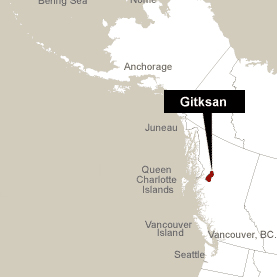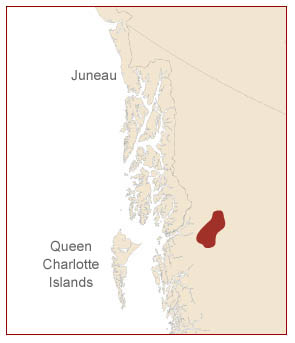
The Gitksan, “People of the Skeena”, come from a rich and fertile region just east of the British Columbia coastline lush with moss-padded forests and snow-capped mountain peaks. Nestled in the watershed of salmon-fat, glacier-fed rivers the primary Gitksan communities lie on the banks of the Skeena River. In this abundant land the Gitksan cultivated pre-contact trade economies with neighboring coastal groups along what came to be known as “grease trails”, after the primary commodity: oolichan, or smelt grease. A matrilineal society, the traditional social structure of the community is based on Wilps, or House Groups. A Wilp is a self-governing organization of closely related people similar to a city or village found within a larger district. The House Groups belong to four clans: Wolf (Lax Gibuu), Frog (Lax Seel/ Ganeda), Fireweed (Giskaast) and Eagle (Lax Skiik). Like the Haida, marriage partners must be chosen from a clan different than one’s own. This tradition allows for diversification of the family and for the expansion of land usage rights between clans.
The Gitksan speak Tsimshianic dialect and although they are closely related linguistically to their western neighbors the Nisga’a, –both nations fall in the Interior Tsimshian cultural group—the Gitksan compromise a distinct ethnic group with separate political interests. Their hardest-won battles have focused on maintaining stewardship of their native lands. Waging almost 150 years of formidable defiance, these tenacious people have fought long and difficult battles to protect their aboriginal lands from the destruction of logging, mining, industry and development. Through their legal battles, most notably the Delgamuukw aboriginal title case, the Gitksan community has helped to set precedents for other first nations of Canada working to protect their aboriginal territories.

The Gitksan are one of many nations of totem pole carvers of the Northwest Coast. In the exquisite older examples that still remain, the striking similarities among the Haida, Tlingit and Tsimshian styles are apparent: the fluid bears and beavers silently speak their intricately carved family histories; eyes staring wide to witness the passages of what their land their people have known.
During the 1940’s the Gitksan community became interested in preserving artifacts from their rich cultural traditions. With the assistance of the community and government funding, the Gitksan community were able to create the ‘Ksan Historical Village and Museum. In 1970 this cultural and performing arts center opened a carving shed which housed the school of Northwest Coast Indian art. This school was integral in preserving the carving traditions of Northwest Coast Native groups and for disseminating information on materials and techniques traditionally employed by Native carvers. Many of today’s Master artists participated in or attended the activities at the ‘Ksan School of Northwest Coast Indian art.
